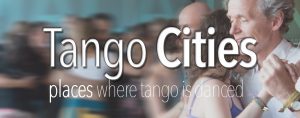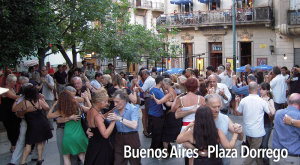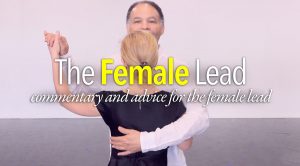The reality is that a lot of Followers close their eyes. They do this for a variety of reasons. a.) To blot out their surroundings so that they’re not distracted by anything. b.) To be able to focus on their partner’s physical presence. c.) To respond emotionally to the music, and/or their partner. d.) To revel, ugh, deeply in their partner’s physicality of their dance. or e.) All of the above.
However, what some Followers may not realize that is that doing so generates about 30 to 40% of the Follower’s issues along the lines of stability, balance, and vocabulary execution. 30 to 40%!
Looking at the video above, one may be tempted to believe that that’s just that particular Follower, or that the Follower is just a beginner. Or that they just haven’t practiced enough. Or that the Follower has no control over their ‘core’ muscles. Or that the Follower’s heels are too high. Or, or, or….Nope. None of that is true. The reality is that Balance & Stability is not a Follower thing, it’s relevant to both roles. Truthfully Balance & Stability issues happens with a lot of people. Modern Dancers, Ballerinas, and believe it or not Yoga Practitioners. Yes, Yoga Teachers who are acutely aware of their own physicality, and most certainly their balance and stability through use of their muscular and a heightened neuro-awareness. They should rightfully know when they’re off balance. Nope. This isn’t a particular Follower thing. Nor is it a technique thing. This is a human thing. However, that little fact is lost on people. The Follower gets blamed for pulling the Lead off. Which may have happened, however, the Lead may have landed their foot incorrectly which started the whole instability thing in the first place. The key here is that Balance & Stability are not just a Follower issue. They’re a Dancer Issue! And that is where we start Today’s Tango Thought #138!
Now to some uncomfortable facts about your Balance and Stability, where it comes from, and how it’s generated. Warning! Fact based information coming. Not supposition. Not wild fantasy by some webpage trying to sell you something. Nope. Facts folks. Pure fact. You’ve been warned. 😉
1.) Your physical balance is not generated by your ‘core’ muscles. One (your balance) has nothing to do with the other (your ‘core’ muscles). Your balance is generated by your inner ear. Without the inner ear, and its vestibules you’d be a wobbling mass! Put simply, the inner ear is what generates your ability to discern your center balancing point. It does this through an ingenious 3 axis vestibule system of micro-fluid that moves a lot like Carpenter’s Level would. And as the fluids move, they pass over nerve endings that then send that information onto the Cerebellum.

2.) Your stability, which is your balance in motion, is generated by the cerebellum. So as you move, your cerebellum, in concert with the inner ear, is constantly making adjustments to your muscles and nerve impulses to allow you to stay upright.
3.) As we grow older, and our inner ear becomes less and less attuned, less aware to the micro fluid changes that are happening. Further, the nerve endings that sit inside the 3 axis vestibules becomes stiff or rigid, and as a result we tend to begin to miss tiny changes in our balance point. Oh and our hearing diminishes too. 🙁 And ‘older’ in this case is anything older than 18 or 19 years.
4.) As the hearing or sound sensitivity diminishes, and thereby our balance sensitivity, we compensate with something else: Our Eyes!
Those are the facts.
So as lovely as it is to close your eyes while you’re dancing, what you’re really doing is generating whole ranges of instability!
Looking at the video above it’s easy to extrapolate that the end user can generate an enormous amount of instability just by closing their eyes in a standing position. Now if that person moves with their eyes closed…. Uuuuugh. They’ll wander aimlessly and misstep everywhere! And yet, this is precisely what every Follower reading this does when they close their eyes.
To be clear: The instability that is generated is felt in the execution of vocabulary as: A slight misstep by a millimeter or two either towards or away from the Lead. Or as a minor weight mislanding, a shift as you land your foot. Or as a minute, and imprecise, extension of your leg which the Follower then uses their hands and arms to correct for the issue. Mind you these are tiny weight changing issues. They’re tiny wobbles. That by themselves appear as ever so slight missteps. And they mean nothing but when you add them together they create a very real world problem of Balance and Instability. Which translates to the Lead through the Follower’s Embrace as the Lead feeling physiological pressure and compression from the Follower’s hands and arms or “Jesus Christ this Follower is off their axis!”.
Now…go back and re-read that entire thing, and replace the opposite role’s words! Lead for Follower and Follower for Lead.
One more way of looking this stuff – Think of an Ice Skater. Now imagine an Ice Skater closing their eyes in the middle of a competition! No matter how many times they’ve done this their eyes are always, always, always open. Always. Or how about a Gymnast ? Think of that one for a moment. Can you imagine a Gymnast doing that ? And for what reason ? So that they can ‘feel’ the pulse of the music ? Seriously ????? Forklift Operator ? Shipping Captain ? Commander of Naval Vessel ? A Surgeon ? Can you imagine a Board Certified Surgeon doing that ? S/he’d lose their license to practice surgery ever again for as long as they live! So not going to happen. So why would YOU, the Tango dancer, close your eyes in the middle of a song ? For what purpose ? Seriously ???!?!??!
Side Note: Just so that we’re clear, the tried and untrue phrase that gets used frequently, “on/off your axis” is a complete and utter misnomer and doesn’t mean what you think it does. That’s a topic for another day.
To be Fair: There are some Leads that appear to close their eyes. And some actually do. And nothing seemingly goes wrong with them! And still another point, is that the size of the step, as well as if there is any disassociation or applied disassociation (what you erroneously think of as a ‘pivot’) being taken does greatly affect the balance and stability issue. Hmmm and still another point, speed is an issue here as well.
So let’s address those two and half points.
1.) The Lead that closes their eyes. Yup. There are more than a few Leads that close their eyes when they’re dancing for all the same reasons that are listed above. Only in their case, they close their eyes mostly to focus on their Follower’s body position and placement. Some do it for purely hedonistic reasons. And yes, it is hedonistic to revel in the body pleasures of others when you are unfamiliar with that person. There’s nothing wrong with it. It becomes ‘wrong’ when it crosses the line beyond the Follower’s boundaries of what is good behavior. However, if you stop and you think about it, Leading is a lot like driving a car. Pardon the analogy, please. So if you’re driving your car and you decide to close your eyes for any period of time, then the chances increase exponentially that more than likely you’re going to wrap that car around a tree, building, or another car, or worse…another person! So….ummmm…not so much with the closing of the eyes thing Leads. Tsk, tsk, tsk. Not.
2.) The size of the step does have an effect on the stability issue. The larger the step, the more chance for a ‘Thud!‘ to occur, as well as a mislanding, and a misweight transfer. The smaller the step, all that stuff disappears, and there is no balance and/or stability issues that are generated. And when we say “smaller” we’re talking about no more than a centimeter, larger than that and things get wobbly. The ability for you to walk a straight line by moving no more than a centimeter is easily done by most people. But try extending that out to 2, 3, or 4 centimeters and things get challenging. And now we add into the equation, the not walking a straight line, but disassociation and applied disassociation: Your Ochos, Your Molinetes. Uuuuugh. You can easily see where this stuff gets absolutely crazy. And that’s not even mentioning the body tilt that happens in the Follower’s Molinete from the Follower as they employ their back step, nor is it talking about the very frequent issue of the Follower stepping away from their Lead in the Molinete, nor is it talking about the reason why that happens (the Lead’s hips are in the way), nor is it….none of that has a bearing on one’s own stability in motion on a curve!
2.5) And last but not least is the Speed Issue. The faster that you do things, the easier it is for things to go horribly wrong. The slower that you do things, the more chances occur for absolute, and precise, physiological control. However, that’s more than likely NOT going to happen because almost no one, sadly, dances at half-time speed to a tango, vals, or even milonga (known as Single-Time Milonga).
How to Fix the Problem ? OPEN YOUR EYES! It’s pretty much a foregone conclusion that you’re not going to do this. There are many reasons why you won’t which range from “Dude! You’re harshin’ my vibe!” to “Not true!”. We also know that for some of you reading this it will break your concentration. For some it will be really awkward for a time. For some you just will not accept this as reality, and you’ll think or believe that you’re the exception to the rule and that you’re ‘special’. You’re not. This problem exists for everyone. Everyone. There are just some that hide it better than others! We also know that this tango thought is not confirming your Tango Biases. You’ve seen so many other Followers doing it. And they ‘look’ stable. They’re no wobbling. They’re not wavering. They’re not all over the place. While it’s true that some, and we’re talking a very small percentage of Followers do posses the kinesthetic ability to sense their surroundings through the body’s natural electrical field and then translate that information into distance, space, and time, and thereby make a split second decision about where to…utter bullshit. Or as we like to say around here: NOT. It’s called neurolytic practice! If you do train yourself to do something enough times, it will respond in a very specific way after a certain point with exactitude. For those Followers that have done the precise work, where they have trained, taken ooodles of privates, and then continued to train, and train, and train all the while getting compensation feedback from their teachers and dancers, while continuing to train for months on end til they bled…then yeah, they can tune out. Unless, however, you’ve done that….then sadly, you’re still going to be unstable, and unbalanced. And that means YOU NEED TO Open Your Eyes.
Here’s the kicker: Most, if not all, of the LEADS WILL RECOGNIZE A DIFFERENCE if you open your eyes.
Unfortunately, and sadly so, they will attribute the difference in you to something else that they barely understand…such as your walk, your embrace, etc. None of that is real. The reality is that your stability and your balance has improved, but only slightly. Don’t mishear that this is a catchall, or a one-trick-fixes-everything. It’s not. It is a slight improvement. And we do mean minor, very minor. But those changes in your balance and stability occur everywhere. The situation is that, as a result, you’ll seemingly be more ‘grounded’. Also not true. The fact is that your eyes are compensating for the inner ear not generating the proper balance points! Your eyes are doing their job. And if you close them, you will generate a part of what Tango Topics calls Tango Noise (See: Tango Noise). But those minor changes will be felt by your Lead (the person, not the action).
Mind you this speaks nothing to the Follower being imprecise when it comes how and where the Follower is placing their foot in their forward, side, or back steps. Nor how the Follower is landing their foot in those steps. Nor how the Follower, in specific foundation vocabulary, such as the Follower’s Molinete, Traveling Ochos, and the Argentine Cross engages that vocabulary with their Embrace and tries to compensate for their lack of balance and stability. It speaks nothing to the 2 or 3 millimeters (See: 2 or 3 Millimeters) distance or margin for error that can and does happen while walking and dancing with a partner. It also speaks nothing to Bumper Car Tango that happens with some frequency. Nor does it speak to the important and rampant fact of the Lazy Man’s Turn. Nor does it even mention the Reality of Manhandling the Follower (tsk, tsk, tsk). Nor does it even begin to cover the Arm Pit Dancer (tsk, tsk, tsk). Nor does it talk about the micro compressions of the Follower using their hands to compensate for the instabilities. Nope. None of that stuff. Those things STILL need to be addressed.
By itself this slight improvement means very little, however when you put it on top of those other things mentioned above, it changes everything!











